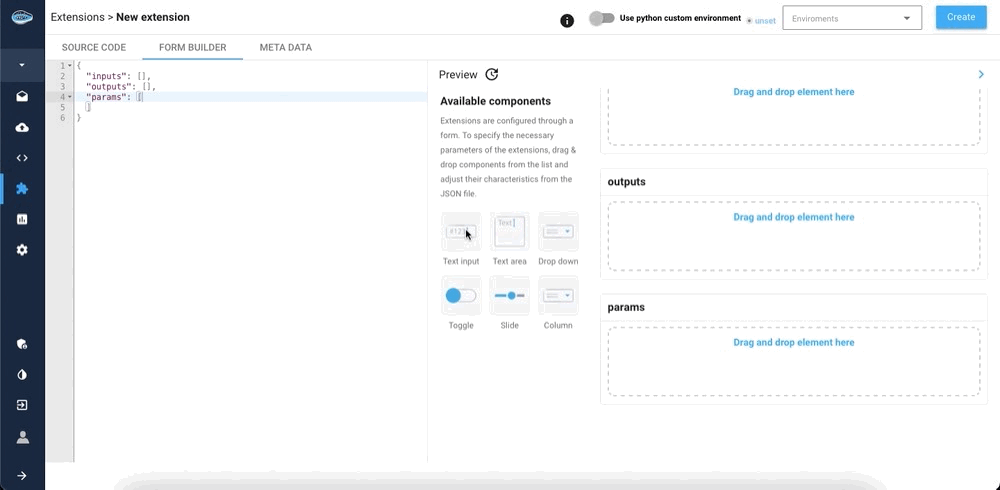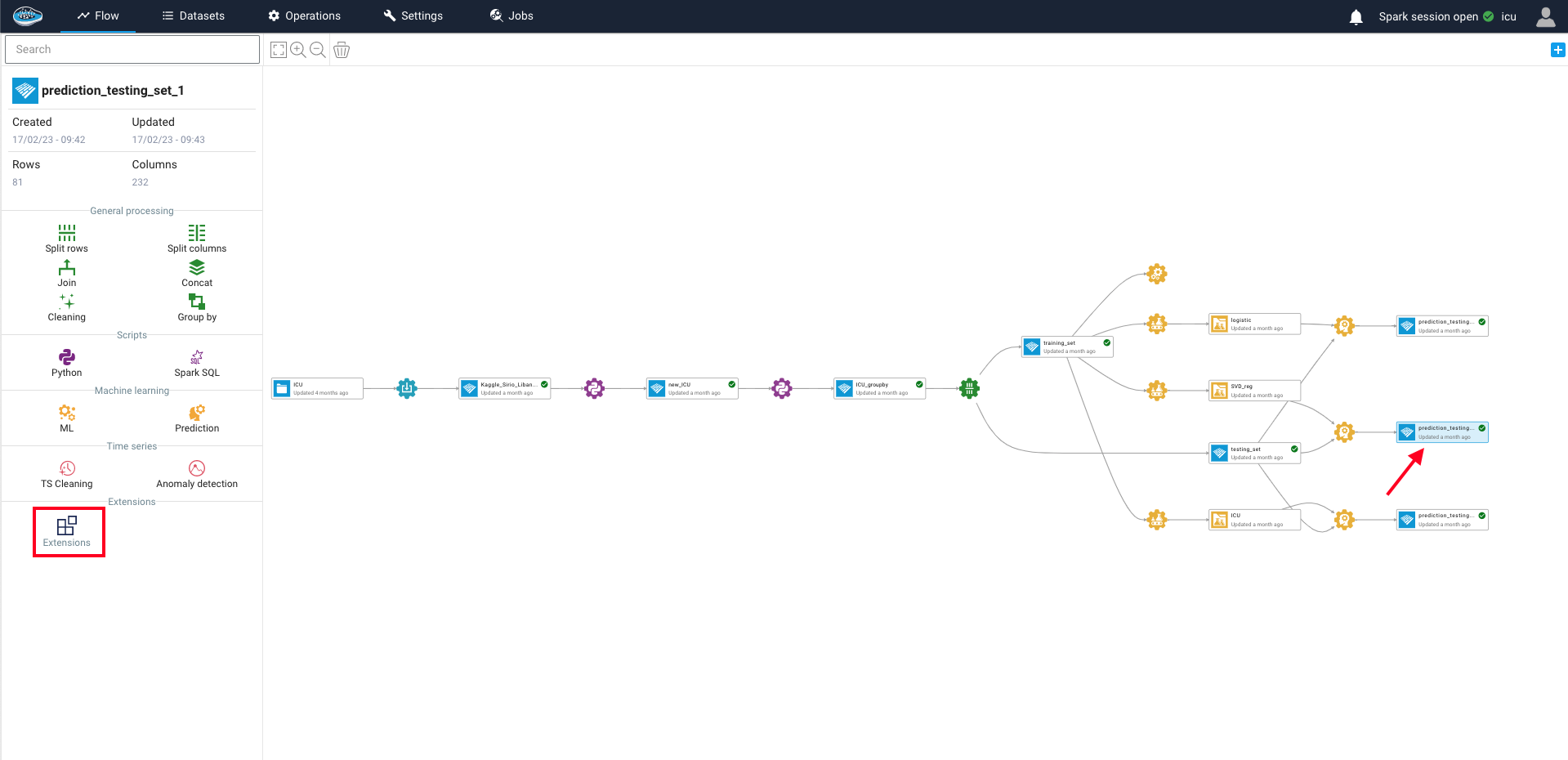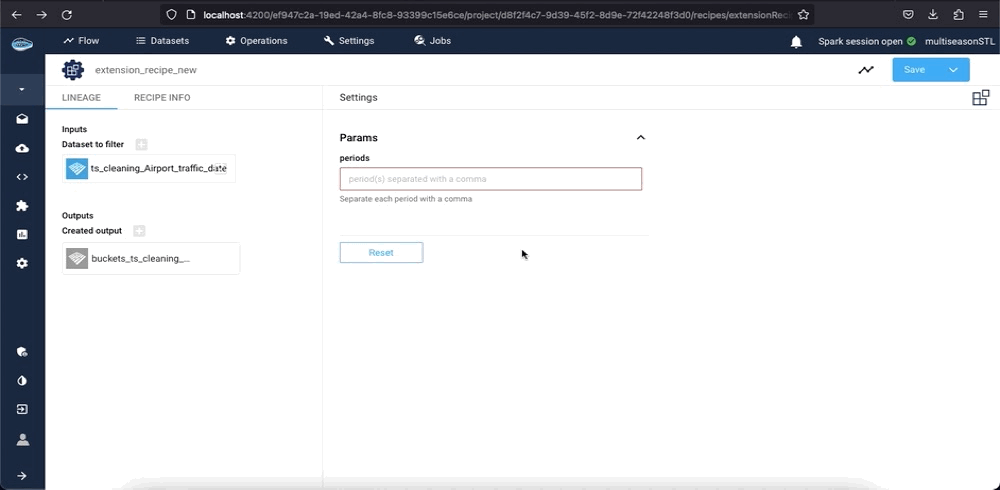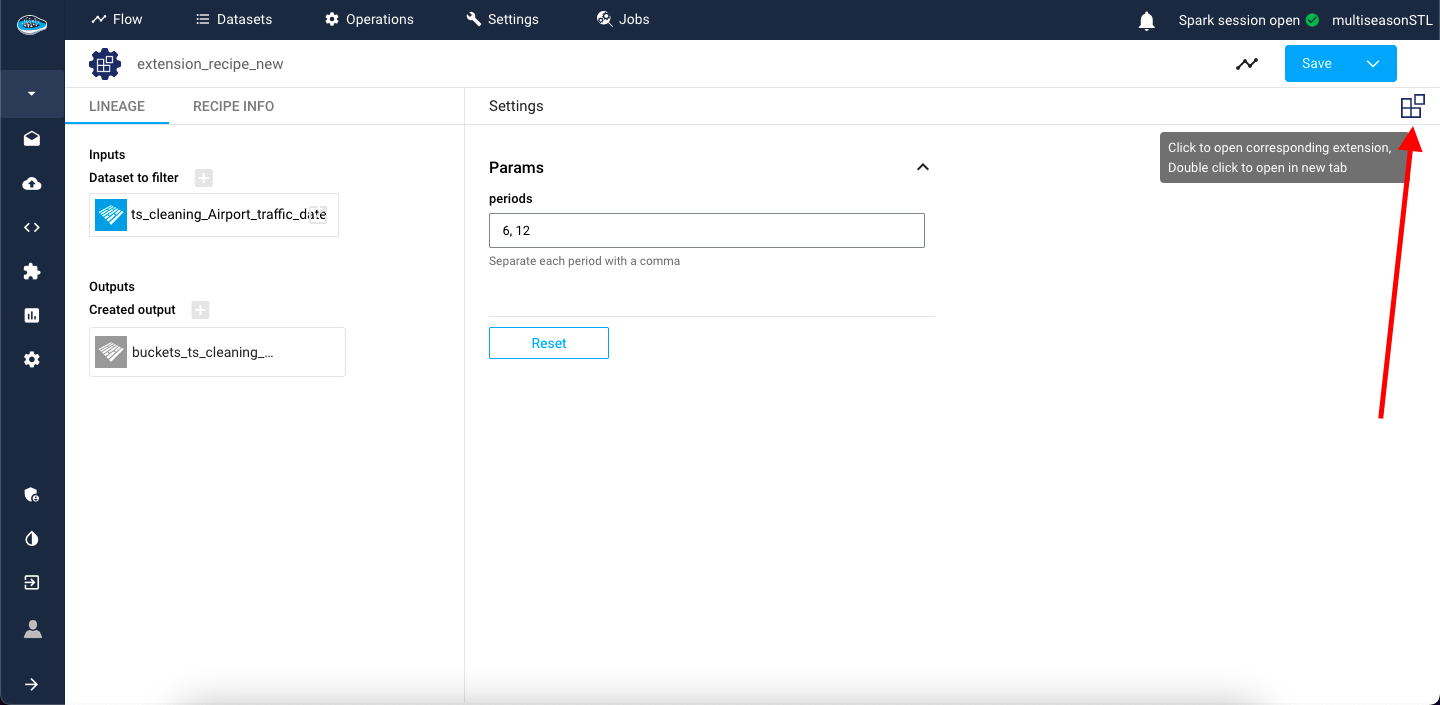Extensions¶
With the papAI tool, users have access to a wide range of options for data preprocessing and analysis. These options allow for common operations to be performed quickly and efficiently.
However, for users who require a more tailored solution, papAI offers a powerful tool called Extensions.
This tool enables users to create custom tools from scratch that can be applied to any dataset or bucket of their choosing. With Extensions, users can tweak the different parameters necessary to run their custom tool correctly, ensuring that it meets their specific needs. Whether exporting data into a single file or multiple ones, Extensions provides a highly customizable solution for data analysis, preprocessing or data viz...
By exploring the full capabilities of this tool, users can unlock new targeted insights and gain a deeper understanding of their data.
Access to the extension list¶
If you're looking to expand your data analysis capabilities, papAI's Extensions feature is an excellent place to start. To access the list of existing extensions, simply click on the extensions tab in the left-hand side menu.
Here, you'll find a vast catalog of pre-existing extensions that are ready to use on any dataset within your projects. Extensions can be identified by their name, author and tags.
Info
If you have granted access, you can also modify the content of the extension to your likings and you simply update it when satisfied.
Create your own extension¶
papAI offers a vast selection of extensions to choose from, but sometimes users require a more personalized solution. PapAI allows users to create their own extensions with custom python code, dedicated virtual environnement, and form builder to tailor the extension to their specific needs.
To access the creation interface, users can simply click on the New Extension button located on the top right corner of the screen.
When you create a new extension, you have access to three tabs:
- The source code tab provides a file explorer on the left side, where you can create new files by clicking on a folder, then on the
Create python filebutton. - The form builder where you can customize inputs, outputs, and parameter fields. Note that you must have at least one input and one output (use the
Text inputelement for both of them). You can drag-and-drop components from the list to add parameters. They will be shown when you click on your extension in your flow. - The meta data tab where you can edit the name of your extension, the tags associated with it, its description and its icon.
Tip
For the python recipe, there is multiple instructions to import/export correctly either data or parameter needed for the code to run as you like.
Info
The python recipe include also the basic and useful libraries commonly used such as Pandas or NumPy but you can also use a custom Python virtual environnement using a specific list of libraries that you need for coding.
Finally, users can click on the Create button to save their unique new extension.
Developing the extension¶
PapAI provides functions to interface with your buckets (see more on buckets).
delete_large_files(bucket_name, remote_path, size_threshold, recursive=False, only_print_files_to_delete=False)
Delete files in a bucket that are larger than a threshold.
Parameters:
-
bucket_name(str) –Name of the bucket to delete files from.
-
remote_path(str) –Path to the files to delete.
-
size_threshold(int) –Number of bytes above which files will be deleted.
-
recursive(bool, default:False) –Whether to delete files recursively in
remote_path, by default
False. -
only_print_files_to_delete(bool, default:False) –If True, disables the deletion of files and only prints the path to
files that would be deleted, by default False.
Examples:
>>> delete_large_files(
... "my-bucket",
... "path/to/",
... 12_000_000,
... only_print_files_to_delete=True,
... )
Would delete "my-bucket/path/to/file1.txt" (15000156 bytes)
Would delete "my-bucket/path/to/file2.txt" (16124156 bytes)
>>> delete_large_files(
... "my-bucket",
... "path/to/",
... 12_000_000,
... recursive=True,
... only_print_files_to_delete=True,
... )
Would delete "my-bucket/path/to/file1.txt" (12000001 bytes)
Would delete "my-bucket/path/to/file2.txt" (1009000145 bytes)
Would delete "my-bucket/path/to/archive/file2.txt" (95408192 bytes)
Would delete "my-bucket/path/to/awesome/marco.txt" (13020153 bytes)
>>> delete_large_files(
... "my-bucket",
... "path/to/",
... 12_000_000,
... )
delete_old_files(bucket_name, remote_path, date_threshold, recursive=False, only_print_files_to_delete=False)
Delete files in a bucket that are older than a given date.
Parameters:
-
bucket_name(str) –Name of the bucket to delete files from.
-
remote_path(str) –Path to the files to delete.
-
date_threshold(datetime) –Date threshold to delete files older than.
-
recursive(bool, default:False) –Whether to delete files recursively in
remote_path, by default
False. -
only_print_files_to_delete(bool, default:False) –If True, disables the deletion of files and only prints the path to
files that would be deleted, by default False.
Examples:
>>> delete_old_files(
... "my-bucket",
... "path/to/",
... datetime.datetime(2021, 1, 1),
... only_print_files_to_delete=True,
... )
Would delete "my-bucket/path/to/file1.txt" (Last modified: 2020-12-31 08:29:02.53157)
Would delete "my-bucket/path/to/file2.txt" (Last modified: 2020-12-31 23:43:32.09876)
>>> delete_old_files(
... "my-bucket",
... "path/to/",
... datetime.datetime(2021, 1, 1),
... recursive=True,
... only_print_files_to_delete=True,
... )
Would delete "my-bucket/path/to/file1.txt" (Last modified: 2020-12-31 08:29:02.53157)
Would delete "my-bucket/path/to/file2.txt" (Last modified: 2020-12-31 23:43:32.09876)
Would delete "my-bucket/path/to/archive/file2.txt" (Last modified: 2019-08-31 23:43:32.09876)
Would delete "my-bucket/path/to/awesome/marco.txt" (Last modified: 2000-07-09 17:51:02.00000)
>>> delete_old_files(
... "my-bucket",
... "path/to/",
... datetime.datetime(2021, 1, 1),
... )
export_dataset(dataset, dataset_name)
Write a pandas DataFrame to a parquet file in the papai bucket.
Parameters:
-
dataset(DataFrame) –Pandas DataFrame to write to the bucket.
-
dataset_name(str) –Name of the dataset to write to.
Examples:
>>> import pandas as pd
>>> df = pd.DataFrame({"a": [1, 2, 3], "b": [4, 5, 6]})
>>> export_dataset(df, "my-dataset")
get_from_bucket(bucket_name, remote_paths)
Download files or folders from a bucket to the local file system.
Parameters:
-
bucket_name(str) –Name of the bucket.
-
remote_paths(str | list[str] | GlobPath | list[GlobPath]) –Path or paths to the files or folders in the bucket.
Returns:
-
str | list[str]–Path to the downloaded file or folder in the local file system.
Examples:
>>> file_path = get_from_bucket("my-bucket", "path/to/file.txt")
>>> pathlib.Path(file_path).rglob("*")
"/tmp/83m2a000r0c90o7" # this is the path to the downloaded file
>>> folder_path = get_from_bucket("my-bucket", ["path/file1.txt", "path/to/file2.txt"])
>>> pathlib.Path(folder_path).rglob("*")
["/tmp/2009ma0983rco/file1.txt", "/tmp/2009ma0983rco/file2.txt"]
>>> # content of folder is copied to `folder_path`:
>>> folder_path = get_from_bucket("my-bucket", "path/**")
>>> pathlib.Path(folder_path).rglob("*")
["/tmp/mar9308720009/file1.txt", "/tmp/mar9308720009/to/file2.txt"]
get_input_buckets()
List input buckets step names in the flow.
Returns:
-
list[str]–List of input buckets names.
Examples:
>>> get_input_buckets()
["bucket1", "bucket2"]
get_input_datasets()
List input datasets step names in the flow.
Returns:
-
list[str]–List of input datasets names.
Examples:
>>> get_input_datasets()
["dataset1", "dataset2"]
get_output_buckets()
List output buckets step names in the flow.
Returns:
-
list[str]–List of output buckets names.
Examples:
>>> get_output_buckets()
["bucket_output"]
get_output_datasets()
List output datasets step names in the flow.
Returns:
-
list[str]–List of output datasets names.
Examples:
>>> get_output_datasets()
["dataset_output"]
glob_bucket_objects(bucket_name, pattern)
List files in a remote directory that match a pattern.
Parameters:
-
bucket_name(str) –Name of the bucket to list in.
-
pattern(str) –List all objects that starts with
pattern.
Returns:
-
list[str]–List of object names that match the pattern.
Examples:
>>> glob_bucket_objects("my-bucket", "path/to/file*.txt")
["my-bucket/path/to/file1.txt", "my-bucket/path/to/file2.txt"]
import_dataset(dataset_name)
Load a pandas DataFrame from a parquet file in the papai bucket.
Parameters:
-
dataset_name(str) –Name of the dataset to load.
Returns:
-
DataFrame–DataFrame loaded from the parquet file.
Examples:
>>> df = import_dataset("my-dataset")
>>> repr(df)
DataFrame({"a": [1, 2, 3], "b": [4, 5, 6]})
list_bucket_objects(bucket_name, prefix='', recursive=True)
List bucket objects with name starting with prefix.
Parameters:
-
bucket_name(str) –Name of the bucket to list in.
-
path(str) –List all objects that starts with
prefix. -
recursive(bool, default:True) –Whether to list files under
prefixrecursively. By default True.
Returns:
-
list[str]–List of object names that match the pattern.
Examples:
>>> list_bucket_objects("my-bucket", "path/to/")
["my-bucket/path/to/file1.txt", "my-bucket/path/to/file2.txt", "my-bucket/path/to/model.json"]
open_bucket_file(bucket_name, file_path, mode, **kwargs)
Open a file in a bucket.
Parameters:
-
bucket_name(str) –Name of the bucket to delete files from.
-
file_path(str) –Path to the file to open.
-
mode(str) –Mode in which to open the file. See builtin
open(). -
kwargs–Additional arguments (such as encoding, errors, newline) to pass to the
filesystem and/or to the TextIOWrapper if file is opened in text mode.
Returns:
-
TextIOWrapper | AbstractBufferedFile–File object.
Examples:
>>> with open_bucket_file("my-bucket", "path/to/file.txt", "r") as f:
... print(f.read())
Hello, world!
>>> import json
>>> with open_bucket_file("my-bucket", "path/to/file.json", "r", encoding="utf-8") as f:
... data = json.load(f)
>>> from PIL import Image
>>> with open_bucket_file("my-bucket", "path/to/image.jpg", "rb") as f:
... img = Image.open(f)
put_to_bucket(bucket_name, local_paths, remote_paths)
Upload files / folders to a bucket.
Parameters:
-
bucket_name(str) –Name of the bucket to upload to.
-
local_paths(PathPattern) –Path to the objects to upload. It can be a glob pattern or a list of
patterns. -
remote_paths(PathPattern) –Path(s) to upload to in the bucket. If it is a list, it must have the
same length aslocal_object_namesand local_paths that are glob
patterns will not be expanded.
Examples:
>>> # puts file at `path/to/file.txt` in the bucket at `file.txt`
>>> put_to_bucket("my-bucket", "path/to/file.txt", "file.txt")
>>> # puts files at `path/to/file1.txt` and `path/to/file2.txt` in the
>>> # bucket at `file1.txt` and `file2.txt`
>>> put_to_bucket(
... "my-bucket",
... ["path/to/file1.txt", "path/to/file2.txt"],
... ["path/to/file1.txt", "path/to/file2.txt"],
... )
>>> # Yields error "No such file or directory" because of `path/to/file*.txt`
>>> put_to_bucket(
... "my-bucket",
... ["path/to/file1.txt", "path/to/file*.txt"],
... ["path/to/file1.txt", "path/to/file2.txt"],
... )
>>> # puts files matching `path/to/file*.txt` in the bucket at `path/to/`
>>> put_to_bucket("my-bucket", "path/to/file*.txt", "path/to/")
put_to_bucket_with_versionning(bucket_name, local_paths, base_versionned_path, remote_path='', version_generator=range(int(100000000000.0)))
Upload files / folders to a bucket. If the remote path already exists,
a suffix will be added to remote_path so that the destination is not
overridden.
Parameters:
-
bucket_name(str) –Name of the bucket to upload to.
-
local_paths(PathPattern) –Path to the objects to upload. It can be a glob pattern or a list of
patterns. -
base_versionned_path(str) –Base path that will be versionned with a suffix.
-
remote_path(PathPattern, default:'') –Path(s) to upload to in the base_versionned_path. If it is a list, it
must have the same length aslocal_paths. By default "". -
version_generator(Iterator[int | str], default:range(int(100000000000.0))) –Generator of version numbers/string to try. You can customize this
to change how the versionned named will be generated. By default
range(10e10).
Returns:
-
str–Path to base_versionned_path with the version added.
Examples:
>>> # If `file_0` and `file_1` already exists in `path/` in the bucket
>>> put_to_bucket_with_versionning("my-bucket", "path/to/file.txt", "file")
file_2
# now the bucket also contains `path/to/file_3.txt`
>>> for _ in range(3):
... path_versionned = put_to_bucket_with_versionning("my-bucket", "path/to/file.txt", "file")
... print(path_versionned)
file_0
file_1
file_2
>>> # If `file_10` and `file_12` already exists in `path/` in the bucket
>>> put_to_bucket_with_versionning("my-bucket", "path/to/file.txt", "file", range(10, 20, 2))
file_14
set_verbose(verbose)
Set the verbosity of the papai_unified_storage module.
Parameters:
-
verbose(bool) –Whether to print debug information.
Examples:
>>> set_verbose(True)
>>> write_to_file_in_bucket("my-bucket", "path/to/file.txt", "Hello, world!")
Writing to file "path/to/file.txt" in bucket "my-bucket"
>>> set_verbose(False)
>>> write_to_file_in_bucket("my-bucket", "path/to/file.txt", "Hello, world!")
write_to_file_in_bucket(bucket_name, file_name, data)
Write data to a file in a bucket.
Parameters:
-
bucket_name(str) –Name of the bucket to write to.
-
object_name(str) –Name of the object to write to.
-
data(bytes | str | BytesIO | StringIO) –Data to write to the object.
Examples:
>>> write_to_file_in_bucket("my-bucket", "path/to/file.txt", "Hello, world!")
Apply an extension to a dataset/bucket¶
To apply the Extensions operation, simply select a dataset or bucket from your project and navigate to the left sidebar. From there, select the Extensions operation and choose the extension that you want to use. A new interface will appear, prompting you to input the necessary parameters and specify the dataset (or bucket) input and output.
Once all the required fields have been filled, simply click the Submit and Run button to initiate the recipe. The extension will then be applied to your data, and the output will be displayed on your project's flow.
Info
You can still look into the extension recipe and configuration if you need to apply any modification by clicking the extension icon, next to the Submit button and you will land on the same page of extension creation. When the modification is done, you submit it by clicking the Update button.
Here is a demo of the Extension module on papAI






